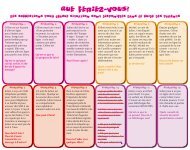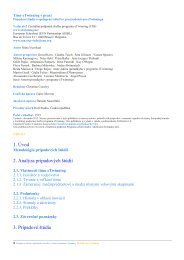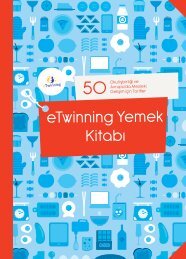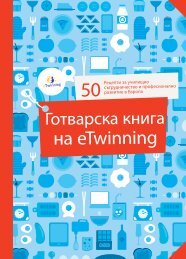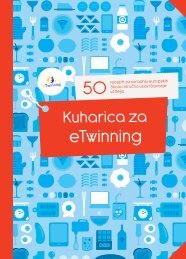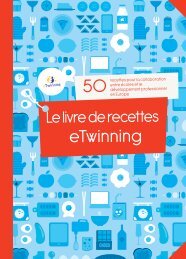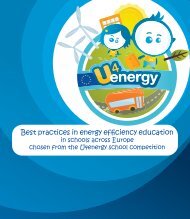Impact of data loggers on science teaching and learning - European ...
Impact of data loggers on science teaching and learning - European ...
Impact of data loggers on science teaching and learning - European ...
- No tags were found...
You also want an ePaper? Increase the reach of your titles
YUMPU automatically turns print PDFs into web optimized ePapers that Google loves.
<str<strong>on</strong>g>Impact</str<strong>on</strong>g> <str<strong>on</strong>g>of</str<strong>on</strong>g> <str<strong>on</strong>g>data</str<strong>on</strong>g> <str<strong>on</strong>g>loggers</str<strong>on</strong>g> <strong>on</strong> <strong>science</strong> <strong>teaching</strong> <strong>and</strong> <strong>learning</strong>use <str<strong>on</strong>g>of</str<strong>on</strong>g> ICT in general; 7 - Make the pupils better underst<strong>and</strong> the research activities carried out in laboratories;8 - Integrate better <strong>and</strong> l<strong>on</strong>ger the knowledge <strong>and</strong> skills acquired by the pupils; 9 - Facilitate pupils’underst<strong>and</strong>ing <strong>and</strong> <strong>learning</strong> <str<strong>on</strong>g>of</str<strong>on</strong>g> <strong>science</strong>s; 10 - Stimulate the interest <strong>and</strong> motivati<strong>on</strong> <str<strong>on</strong>g>of</str<strong>on</strong>g> the pupils for <strong>science</strong>.EFFECT ON PUPILS’ MOTIVATIONEven better, over 80% <str<strong>on</strong>g>of</str<strong>on</strong>g> the teachers found that the activities developed the pupils’ ability touse scientific methods <strong>and</strong> stimulated their interest <strong>and</strong> motivati<strong>on</strong> for <strong>science</strong>: “Generallyspeaking, our students are not highly motivated, their <strong>learning</strong> styles vary a lot <strong>and</strong> levels <str<strong>on</strong>g>of</str<strong>on</strong>g>performance may rise <strong>on</strong>ly if some “h<strong>and</strong>s-<strong>on</strong>” experience is introduced al<strong>on</strong>g with theory<strong>and</strong> fr<strong>on</strong>tal less<strong>on</strong>s” (Italy). For the Italian teachers who participated in the pilot, it seemedthat “<strong>learning</strong> by doing” was the best <strong>teaching</strong> practice to carry out with their students. Theystated that in their educati<strong>on</strong>al c<strong>on</strong>text, lab practices, sharing experiences, netbook <strong>teaching</strong>project <strong>and</strong> 1:1 pedagogies became essential <strong>and</strong> that the supply <str<strong>on</strong>g>of</str<strong>on</strong>g> such technology wascreating big expectati<strong>on</strong>s in both students (<strong>and</strong> their parents) <strong>and</strong> teachers involved.The pilot also had a positive impact <strong>on</strong> pupils’ c<strong>on</strong>fidence with ICT: “We have really enjoyedusing the sensors with our pupils. They have become much more c<strong>on</strong>fident in the use <str<strong>on</strong>g>of</str<strong>on</strong>g> ICTin <strong>science</strong> less<strong>on</strong>s <strong>and</strong> [the school is] now extending the project with other pupils in theschool” (UK).PUPILS’ AUTONOMOUS LEARNINGIt is also positive to note that the teachers felt that the use <str<strong>on</strong>g>of</str<strong>on</strong>g> sensors allowed <strong>learning</strong> forpupils at their own pace <strong>and</strong> speed, which would allow for better educati<strong>on</strong> in classeswhere there are more advanced students al<strong>on</strong>gside students who require more time tograsp difficult c<strong>on</strong>cepts. This aut<strong>on</strong>omous <strong>learning</strong> is not c<strong>on</strong>tradictory to the team workwhich the sensors also encourage (as seen in Figure 34). According to the teachers: “thepupils have worked very well together, supporting <strong>and</strong> helping each other. They have usedthe equipment well <strong>and</strong> achieved some good results” (UK).It seems that, while the sensors supported aut<strong>on</strong>omous <strong>learning</strong> <strong>and</strong> therefore pers<strong>on</strong>aldevelopment at the pupil’s <strong>learning</strong> speed, they also enhanced teamwork <strong>and</strong> networking,which are a key element in <strong>science</strong> research nowadays (Halford B., 2008).In France, a teacher also reported that some pupils took the sensors home or outside to35



